Many Voynich manuscript researchers are puzzled at the large number of letters that stand alone in the VM text. Koen Gheuhus pointed out that in English language, only ‘i’ and ‘a’ can stand alone as a word. In the VM, he noticed that certain glyphs (s, y, l, o, r) appear in isolation over a hundred times, and ‘d’ 44 times.
This, too, is a strong indication that the language is phonetic Slovenian. Slovenian language can logically explain all instances of a one-letter words.
Of the solo letters Koen Gheuhus listed, only O, Y and S were proper one-letter words, however, in the phonetic language, they could also stand for two letter words, where vowel was dropped. Therefore, the explanation is not that simple. One needs to know Slovenian language to make the distinction.
There are several words in Slovenian language that still consist of one letter, such as A, K, H, V, Z, S and O. Except for A, they are all prepositions that were often written together with the next word. As the Slovenian writers became more aware of the importance of grammar, these prepositions were separated with the apostrophy. Eventually, they were totally separated.
In the VM, the writing of these prepositions is inconsistent. The author used his discretion when to separate them, based on the way the combination sounded, or if there was a possibility that the word would othervise be missunderstood, such as the word where O is a pre-fix, not a preposition.
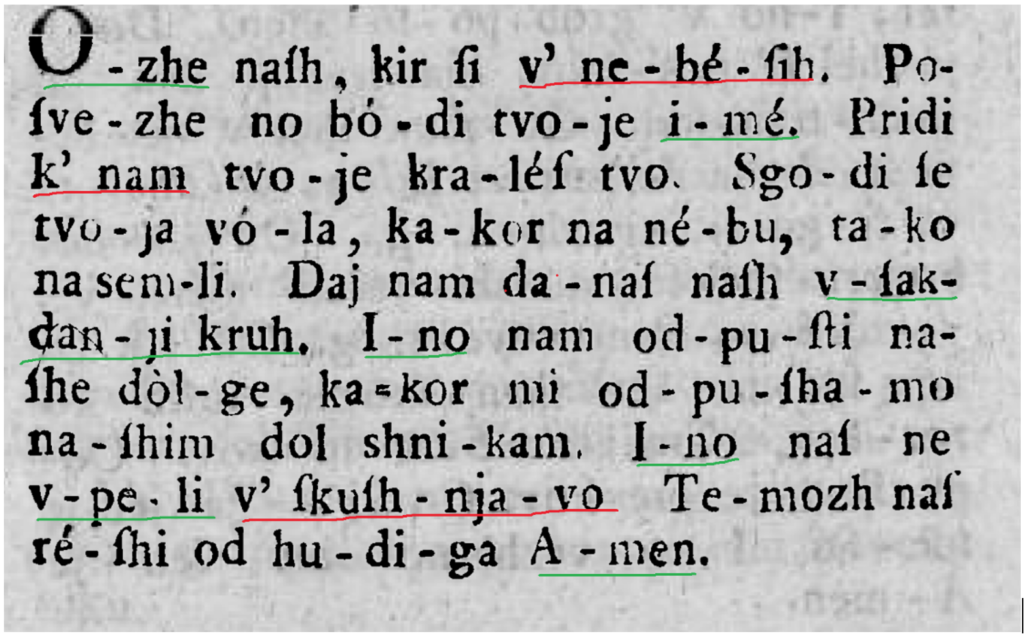
From the above sample of the 16th century Slovenian writing some observations relating to the VM can be made. The above text is divided into syllables for easier learning.
Letters V and K as prepositions are written with apostrophy. Letter V as U (when part of the word) is written as a sillable. Also, the letter I the word INO (and) is written as a syllable.
Another reason why certain VM letters stand alone, is the phonetic speech, where semi-vowels [ə] had no special letter and was therefore not written. This is still the case in Slovenian dialectical speech, where Č Č could be understood as ČE HOČE (if he wants), or D B S KUPU as DA BI SI KUPIL (that he would buy himself something).
At the first glance, this looks like the abjad writing and is much easier to understand in spoken language, than in written form. To solve this problem, the first Slovenian writers inserted e for the semi-vowel. There are still some written Slovenian words where the inserted ‘e’ was not accepted, such as ‘vrt’ (garden), prt (tablecloth), trd (hard). As the grammatical form of such words changes, the vowel can be dropped or aded (pes – psa). In various Slovenian dialects, the vovels weaken into a semi-vowel (sit – sət, sita – sita, kruh – krəh – kruha). While in most Indo-European languages only unstressed vowel can be a semi-vowel, in Slovenian, Bulgarian, Albanian languages, the semi-vowel can also be stressed.
Another reason for the free-standing letter could be the nature of Slovenian syllabic language which reflects in pronunciation as an inapproprate space. In the first Slovenian grammar books, developed by the Protestant writers, the syllabic nature of the language was stressed and used for innitial teaching of reading and writing Slovenian.
Slovenian one-letter words
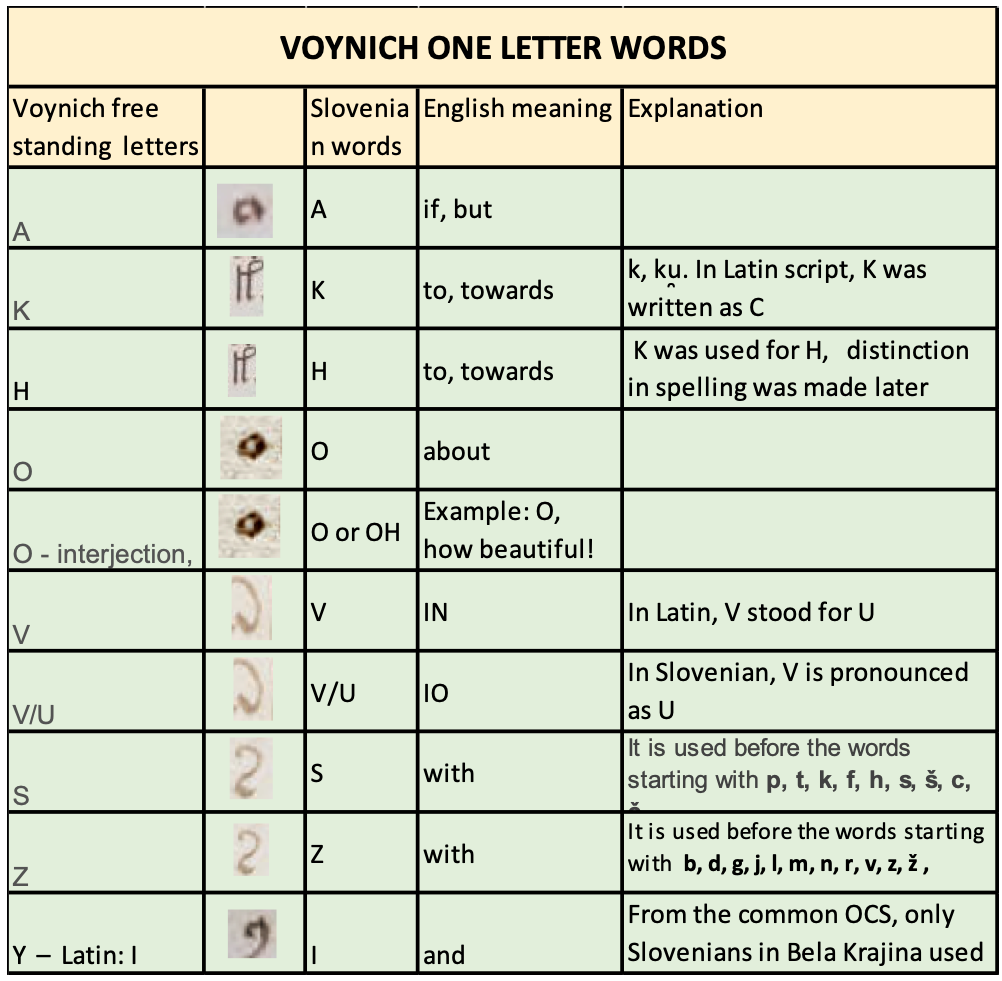
Slovenian language uses much more one-letter words than English. This was the case in the Middle Ages as it is today.
Slovenian two-letter words as a phonetic one-letter words
In the phonetic Slovenian, a vowel was often dropped in a two-letter words. Since the VM language is based on phonetic dialectical Slovenian, two-letter words are often written as one-letter words. Often two or three such words are combined into one. This furter explains the large frequency of some free-standing one-letter words in the VM. Because of the flexible word order, these one-letter words can be found at the beginning or at the end of the word, attached to the word or separated from it.
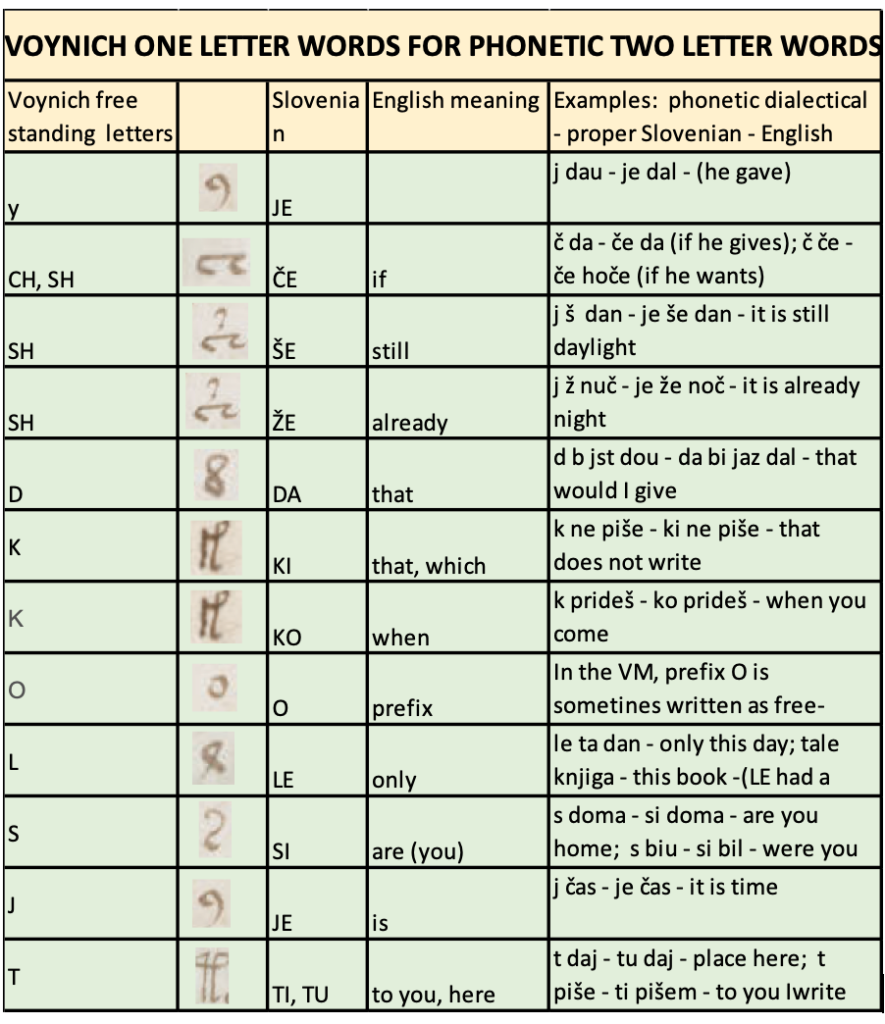
Examples:
A free-standing O is Slovenian preposition (English: about, at ). In the Middle Ages, O was also often used for the preposition V, meaing ‘in’, ‘for’, ‘as’, as well as for interjection.

In the VM text, O is a frequently used preposition, which is written together or separately with the next word. A lot of spaces after O are also due to the O being pronouced as a syllable.
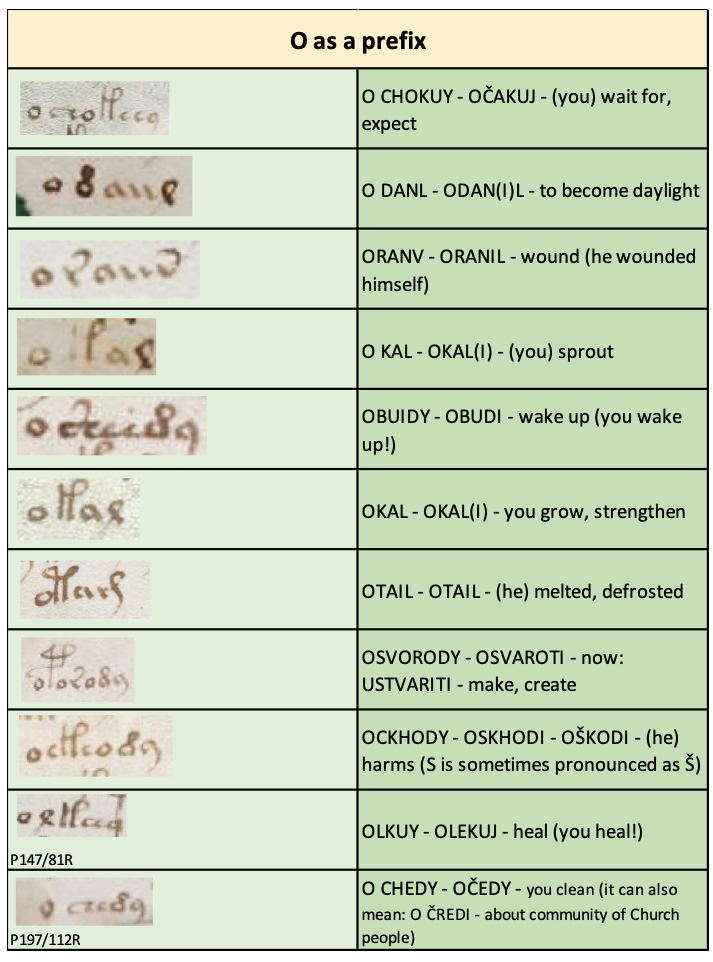
Preposition S
In the medieval Slovenian writing, the letter S was also sometimes pronounced as Z, therefore, the letter Z was introduced later to be used only before the words starting with a vowel or with the letters b, d, g, j, l, m, n, r, v, z, ž.
A short prepositions were often attached to following words and eventually the apostrophy, and later a space, was used to separate such words.
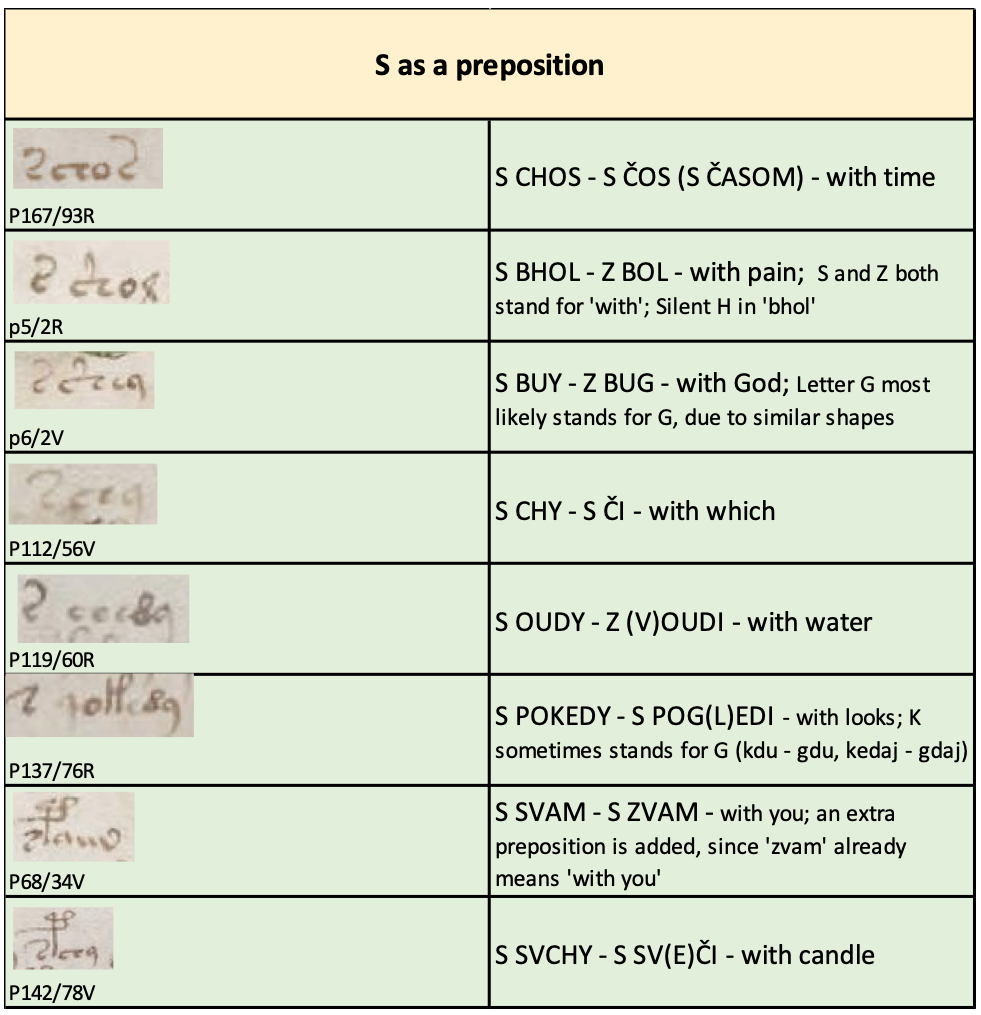
In the VM, free-standing S is often used for the verbal form SI, which in dialectical speech is pronounced as S. As verbal form, S has flexible order in the sentence, before or after a verb. Example: SEM DAL or DAL SEM.
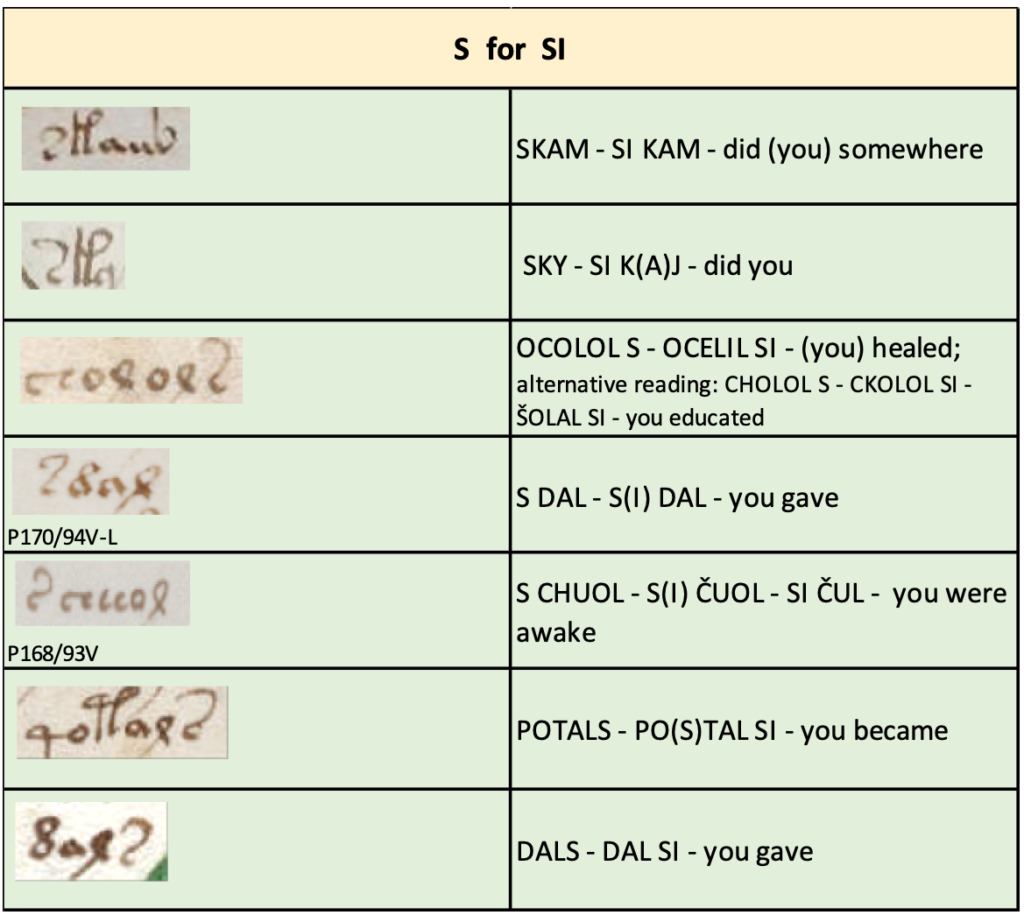
A freestanding S can also be a caused by erronously placed space. For a foreign writer, placing frequent spaces could be caused due a syllabic pronounciation of Slovenian word.
Letter K
A free-standing K is frequently used Slovenian preposition, meaning ‘to’, ‘towards’. In Latin script, K and H were the same, so there was no distinction between the two. Eventually, the letter H was used in front of the words starting with K or G.

In the VM, free-standing K is most frequently used for relative pronouns KI or KO.

Freestanding Y
The Voynich glyph Y is most often transcribed as ‘i’. In Slovenian language, it also served for the sound J, until the letter ‘j’ replaced it. It was still quite frequently used in first Slovenian books. The letter Y is no longer part of Slovenian alphabet.
By the time the first Slovenian book was printed, Slovenian language already had several major dialects (Carinthian, Carniolan, Slovenian, Istrian). The use of Y for the contemporary Slovenian conjunction IN was characteristic for the Pannonian/Illyrian Slovenian dialect, while other dialects used INO. The remnant of the ancient use of the letter ‘i’ for ‘and’ is still noticable in the dialects of Bela Krajina and Prekmurje, where I is still consistently used in dialectical speech. It also became incorporated into Croatian and Serbian literary language. In the writing of Slovenian author Štefan Kuzmič, written in 1771 in the Prekmurje dialect, the words I and INO are used intechangably. Also, the vowel O is often used for the sound OE (VORE), which can explain why the pronunciation of Vovels can differ.
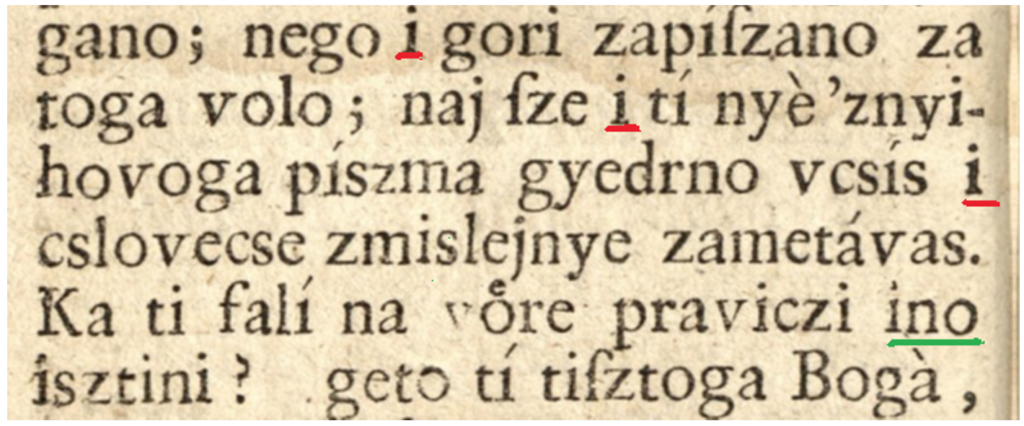
In the VM, the conjunction ‘i’ is most frequently used, sometimes followed and preceeded by space, sometimes the space is omitted. Since Voynich glyph is transcripbed as Y, including in Eva, the distinction has to be made when it stands for ‘i’ and when for ‘i’.
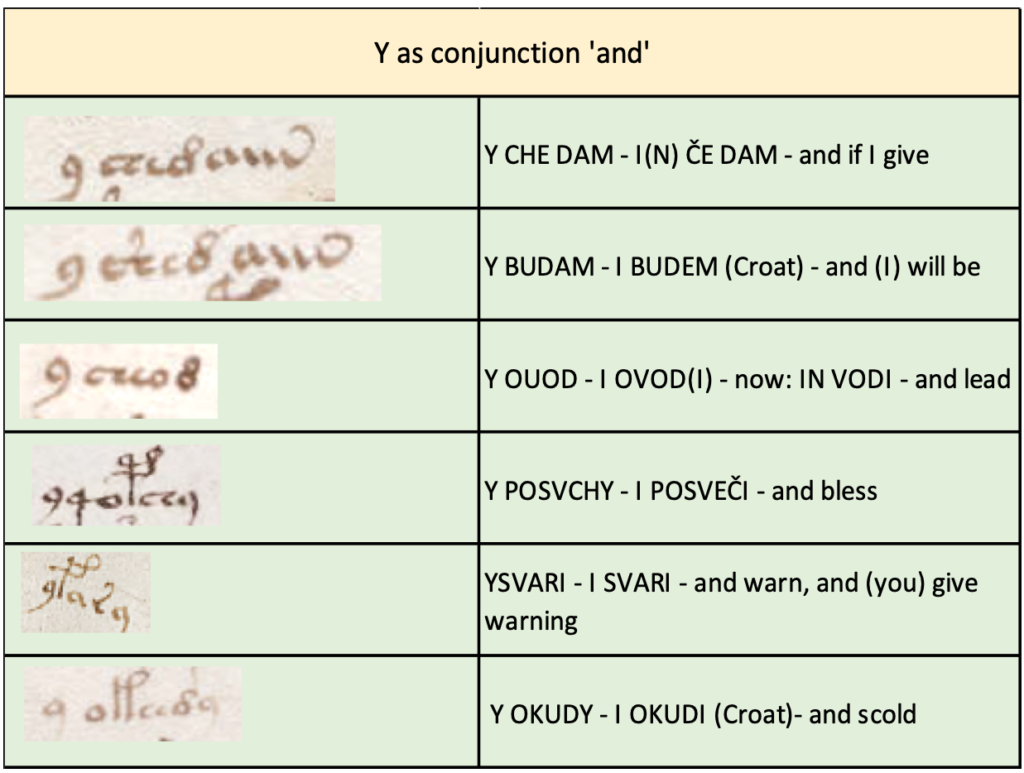
Sometimes the way the Latin Y is transcribed into Slovenian makes a difference. For example, the VM word YDY can either mean JEDI (meals) or IDI (go).
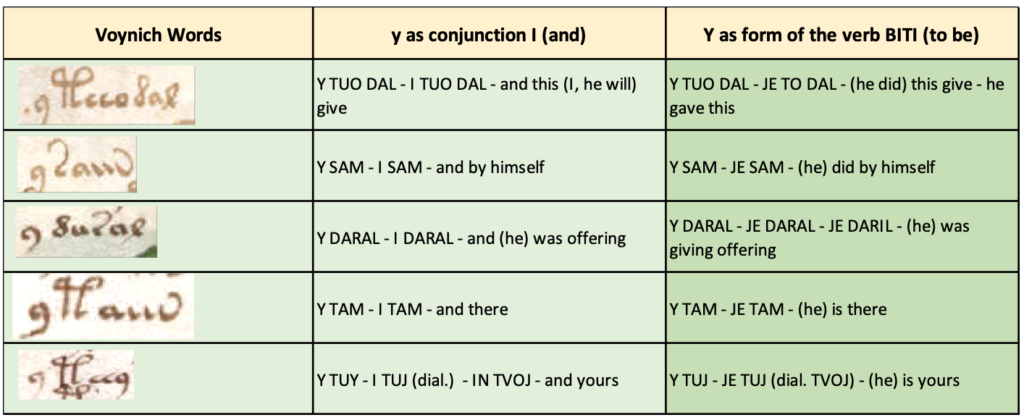
Letters D, Č (ch), Č/Š (sh) L, D, T and SV (Eva F and P) stand for the phonetic two-letter words, which in medieval Slovenian writing are often combined. Therefore, these free-standing letters can have the same meaning when written separately or when they are attached to the next word.
Letter L
VM language is based on the spoken medieval Slovenian, which means that in the two-letter words, a half-sound was often pronounced, but not written. This can explain all free-standing L word. The word LE is very common in Slovenian language. Its main meaning is ‘only’, but in the Middle Ages, it was also used as an article (le ta – this, le eno – only one), and an interjection (le pridi -do come, le povej – tell).

In the VM, L as LE is written separately or without a space.
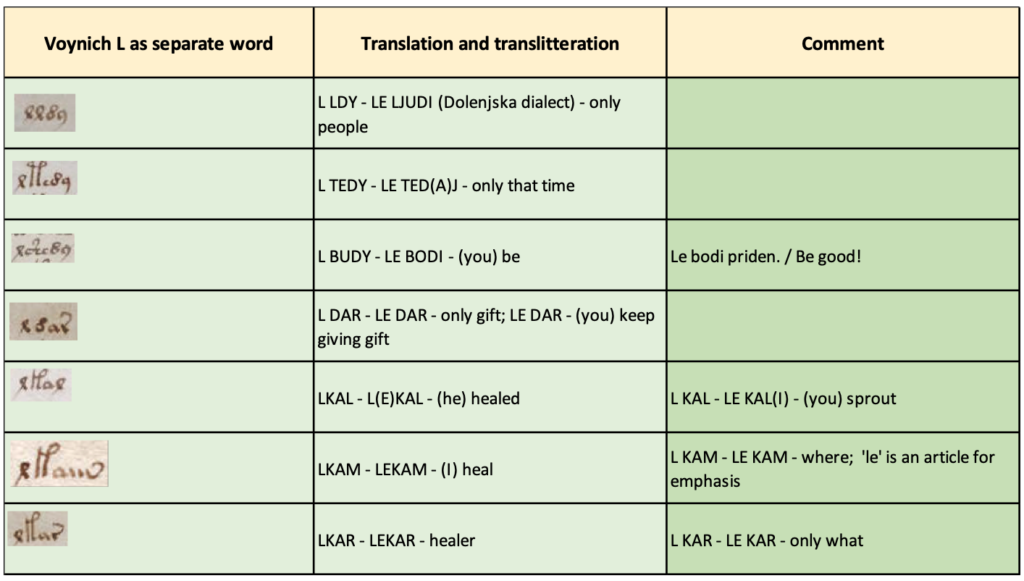
Freestanding R
The main reason for the freestanding letter R is the property of the letter R. A semi-vowel is esentially pronounced next to every R if it is not preceeded or followed by a vowel. Example: RČI – REČI. The letter R also has a soft and hard sound which a foreign writer might indicate with a space.
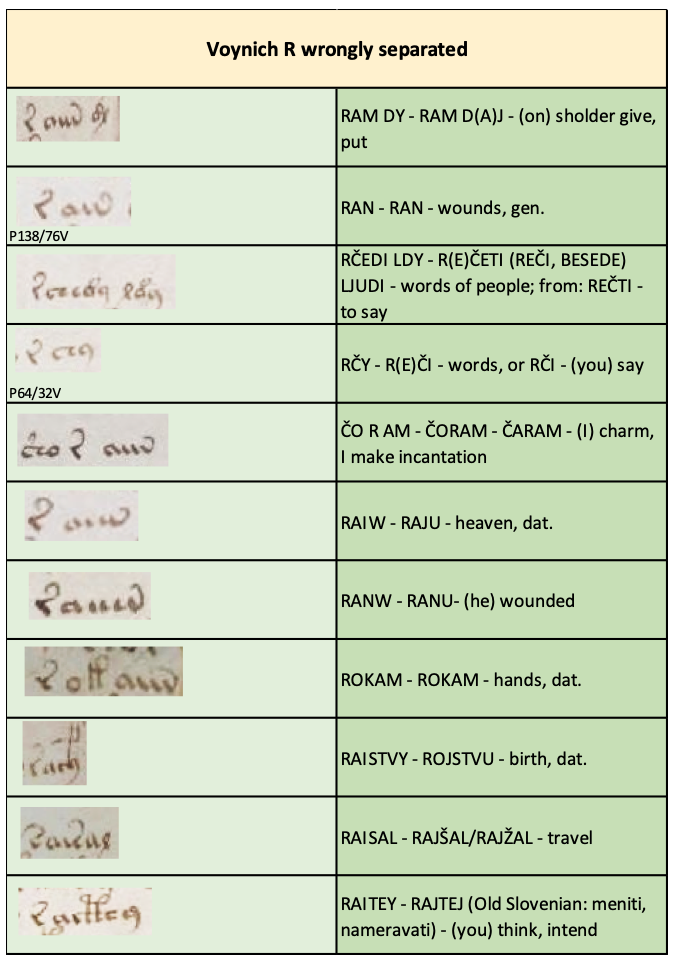
Letter D
Voynich letter D stands for Slovenian DA (that, so that). In the VM, it is writen as a solitary letter or attached at the front or at the end of the word. In the VM, most common cause is improper space.
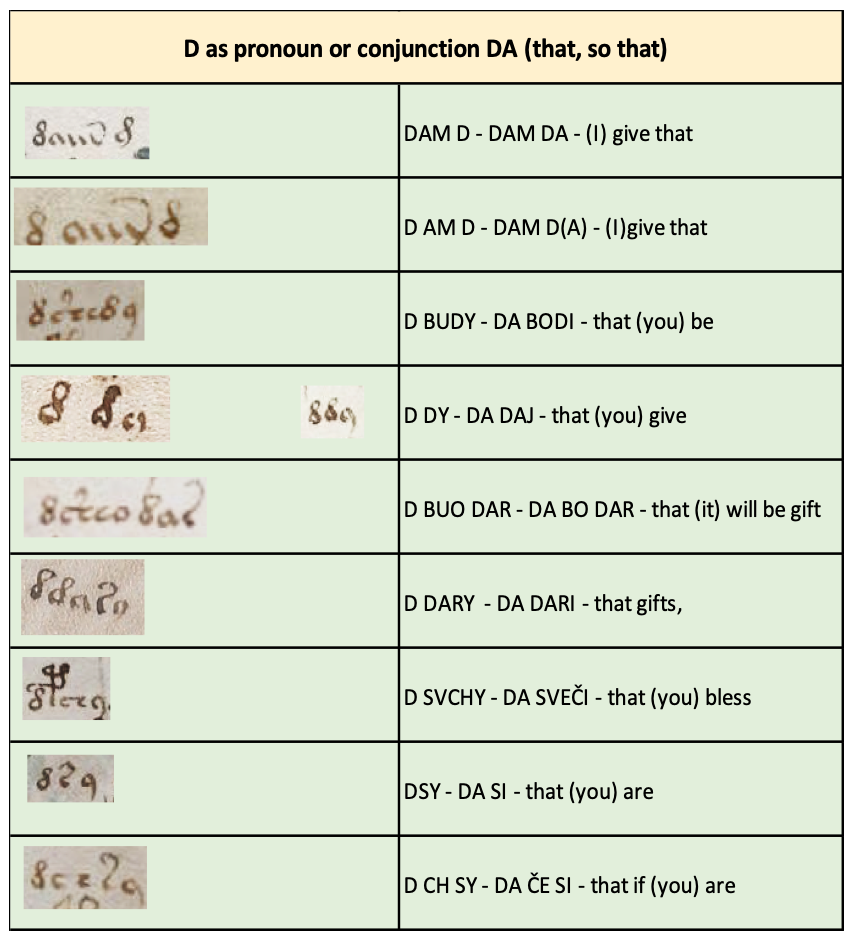
A similar explanation can be made for all free standing CH and SH letters. They stand for phonetic ČE, ŠE, ŽE.
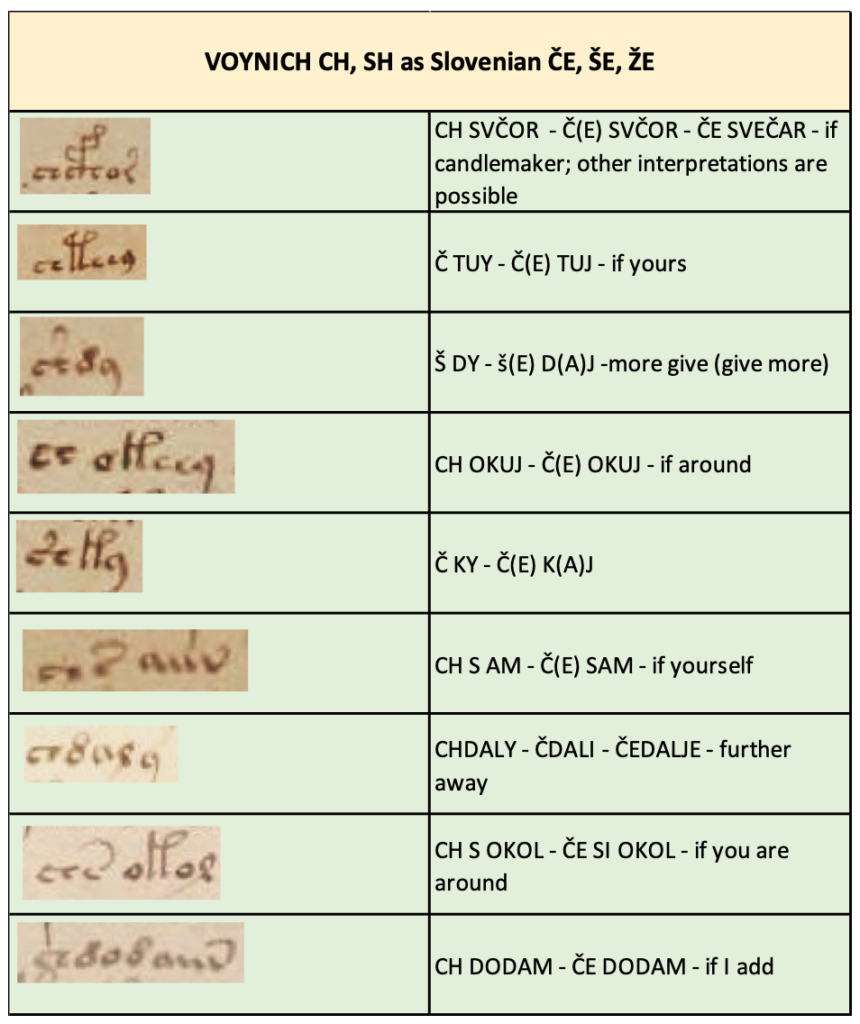
Letter T
The most common reason for a freestanding T in the VM is the semi-vowes that was not written down. In the spoken language, the vowel can be recognized, but in written language it is a lot hader. One needs to know the language to know which vowel needs to be added. Some clue could be obtained from reading the text in context.
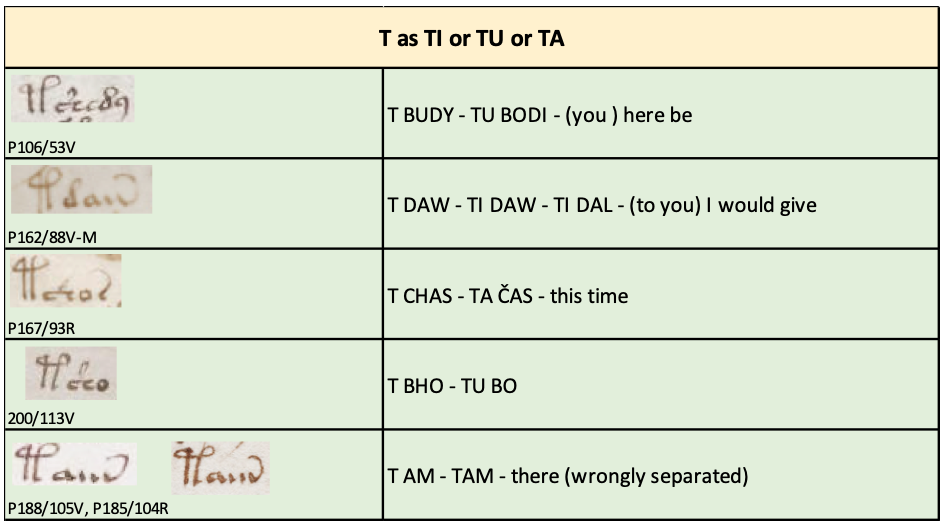
The VM glyphs Eva F and Eva P are used in the VM interchangably for the sounds that sound the same, but have different meanings. I read them as SV (CV, ZV). They require the semi-vowel, which was later replaced with e, i, o or a. The only Slovenian word that is close to SV is CVI (bloom). Since Slovenian language was close to Croatian, I believe the freestanding SV stands for SVE (all), which is still used in this form, however, in Slovenian language, the letters were reversed, so that the English ‘all’ is translated in Slovenian as VSE.
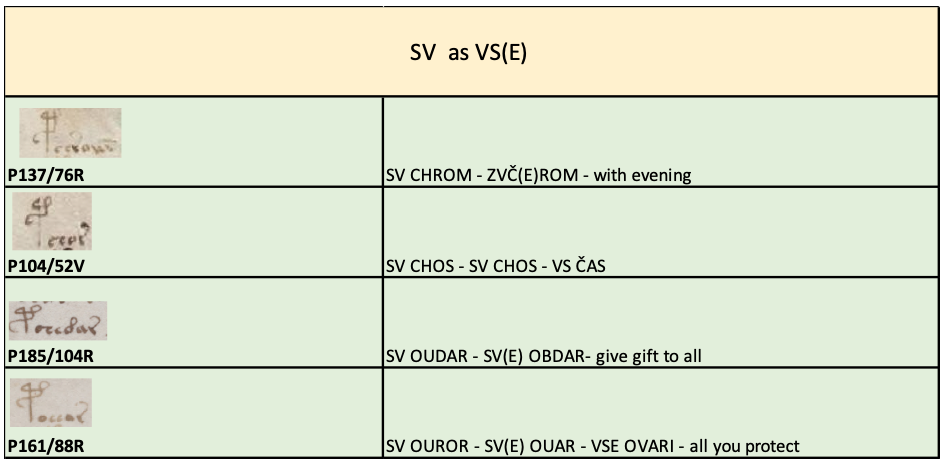
In the VM, there are also two strange glyphs that some VM researchers are regarding as V. This is also how I read them. They are definitely decorative initials and the space after them is due to the large letter V. The word VODAR conforms to the same grammatical form as BRODAR, or ZVEZDAR – a noun + ar (ending for male profession).
The word VIDAW is a verb, in a past or future tens, used with helping verb (sem, si, je or bom, boš, bo – was or will), and also for conditional mood with helping verb ‘bi’ (would).

Other individual letters
In his analysis of VM free-standing letters, Koen Gheuhus also mentions the f49v, where free standing letters seem to represent innitials. They seem to be the first letters of each line, except for three strange glyphs that look like a mirror image of the letter C.
I have arranged them in four columns, living out those special glyphs and to my surprise, I was able to read the acrostich:
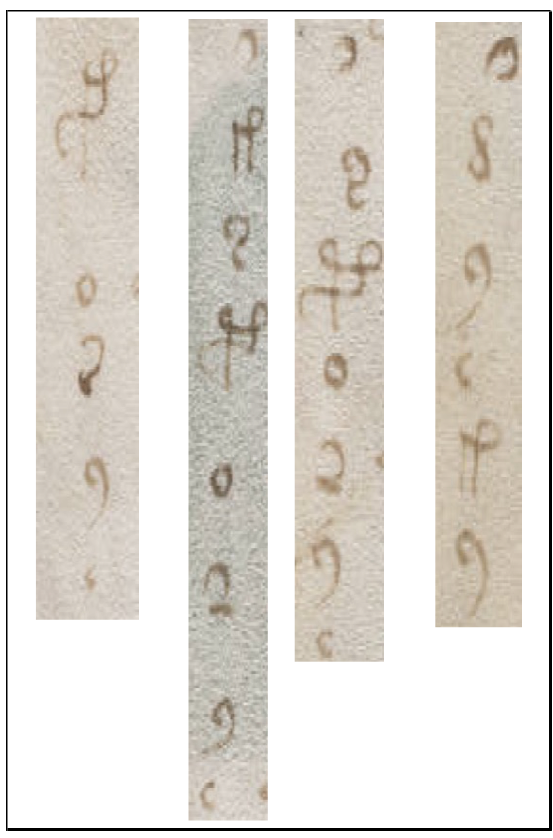
SV ORY K S SVORY S SVORY D Y E KY. After adding a few vowels to change phonetic to proper language, I was able to obtain a meaningful phrase:
SVI ORI, KI SI SVORI(L), DA JE KAJ. (All prayers, you created, that is something; or All prayers you created, are meaningul.)
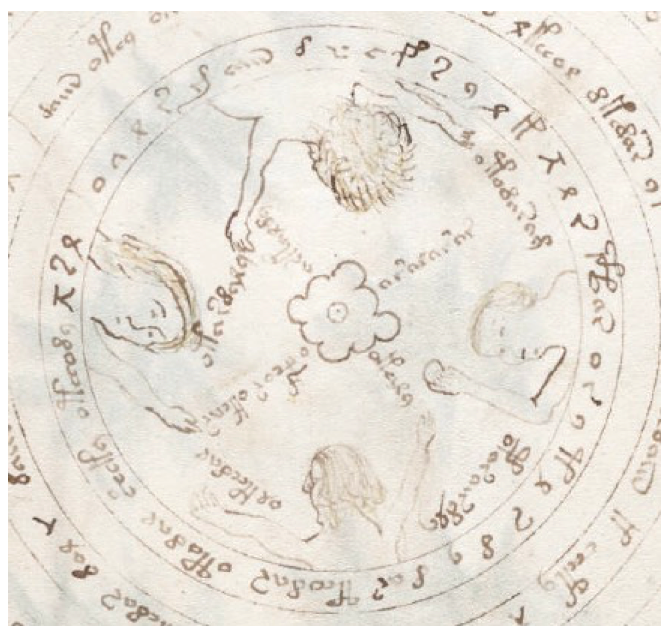
The free standing letters in f57v definitely represent the plan for the development of Slovenian alphabet, comprised mostly from the Latin letters with some glyphs purposely created for Slovenian sounds.
As Koen Gheuhus pointed out, there are also free standing letters in f66R. To me, the page looks like a grammar exercise.
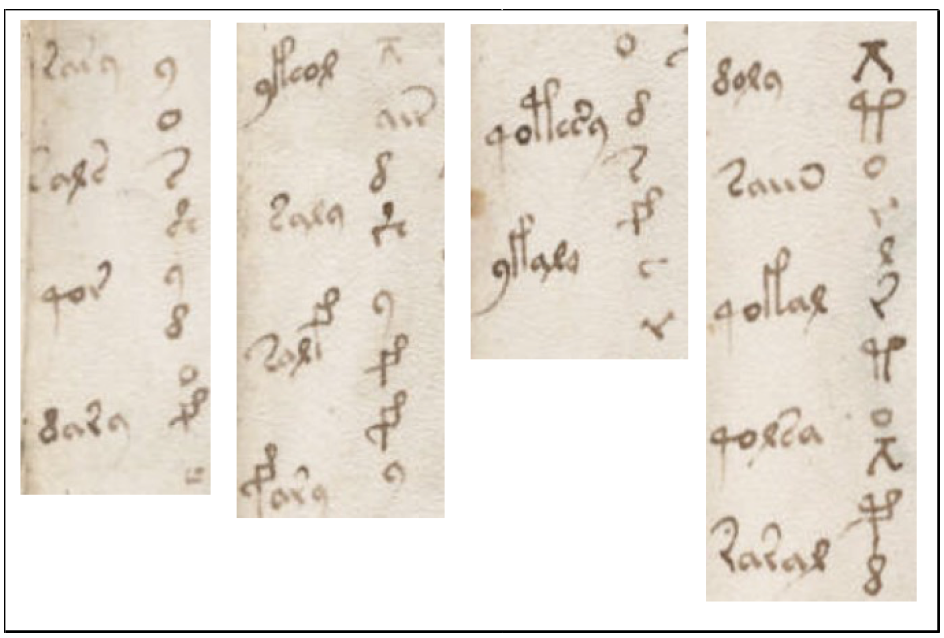
Koen concluded that ‘there must be something special about these glyphs, making them particularly suited to stand by themselves’. He also pointed out that Eva E does not occur as a single glyph, except in f49v (if it is meant to be an actual glyph). He also finds it unusual that P (Eva q) stands alone only on page f76r.
Because the Slovenian language is so archaic and complicated, it is impossible to convince non-Slavic people of all its grammar peculiarities. As a matter of fact, very little research has been done by Slovenian linguists to show the development of the Slovenian language between 10th and 16th centuryes. The dialects have been regarded by the past linguists as a bad vestage from the past that needed to be rooted out of Slovenian written and spoken language.
****UVODNI PRISPEVEK O PROJEKTU SLOVENIJA/SLOVENŠČINA: https://voynichslovenianmystery.com/?page_id=56
******SEE INTRODUCTION ARTICLE OF THE PROJECT VOYNICH MANUSCRIPT SLOVENIAN MYSTERY EXPLAINED AT: https://voynichslovenianmystery.com/?page_id=9
********BASICS: https://voynichslovenianmystery.com/
One reply on “Voynich One Letter Words”
Top site ,.. amazaing post ! Just keep the work on !